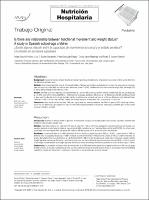Por favor, use este identificador para citar o enlazar este ítem:
https://repositorio.usj.es/handle/123456789/340
Registro completo de metadatos
| Campo DC | Valor | Lengua/Idioma |
|---|---|---|
| dc.contributor.author | García-Pinillos, Felipe | - |
| dc.contributor.author | Roche-Seruendo, Luis Enrique | - |
| dc.contributor.author | Delgado-Floody, Pedro | - |
| dc.contributor.author | Jerez-Mayorga, Daniel | - |
| dc.contributor.author | Latorre-Román, Pedro Á. | - |
| dc.date.accessioned | 2020-02-18T10:48:01Z | - |
| dc.date.available | 2020-02-18T10:48:01Z | - |
| dc.date.issued | 2018 | - |
| dc.identifier.citation | García-Pinillos F, Roche-Seruendo LE, Delgado-Floody P, Jerez Mayorga D, Latorre-Román PÁ. Is there any relationship between functional movement and weight status? A study in Spanish school-age children. Nutr Hosp 2018;35(4):805-810 DOI: http://dx.doi.org/10.20960/nh.1670 | es_ES |
| dc.identifier.issn | 1699-5198 | es_ES |
| dc.identifier.uri | https://repositorio.usj.es/handle/123456789/340 | - |
| dc.description | Background: to examine relations between functional movement patterns and weight status in Spanish primary school children and to determine the differences between sexes. Methods: three hundred and thirty-three, 6-13 years old children (164 boys and 169 girls), participated in this study. The main outcome measures were the body mass index (BMI) and the Functional Movement Screen™ (FMS). Children were classifi ed as normal weight (NW), overweight (OV) or obese (OB) according to international cut-offs. Results: total FMS score was negatively correlated with BMI (p < 0.001). FMS score was different between children from NW, OV and OB groups (p = 0.001), lower with the increased BMI (p < 0.001 between all groups). Signifi cant differences (p < 0.05) between NW, OV and OB were found in deep squat, hurdle step, in-line lunge, shoulder mobility, straight leg-raise and push-up tests. As for the sex differences, girls obtained higher scores (p < 0.05) in in-line lunge, shoulder mobility and straight leg-raise, whereas boys did it in push-up (p = 0.044) test. Conclusions: these results confi rm that total FMS score signifi cantly and inversely correlates with BMI in a group of 333 school-age children. As for the sex differences, girls outperform boys in movements requiring fl exibility and balance, whilst boys outperform girls in tests where muscular strength is required. | es_ES |
| dc.description.abstract | Introducción: examinar la relación entre los patrones de movimiento funcional y el estado ponderal en escolares españoles, determinando también la infl uencia de la variable sexo. Métodos: trescientos treinta y tres niños de 6-13 años de edad (164 niños y 169 niñas), participaron voluntariamente en este estudio. Las variables objeto de estudio fueron el índice de masa corporal (IMC) y la batería de test Functional Movement ScreenTM (FMS). Los niños fueron clasifi cados como normopeso (NW), sobrepeso (OV) y obesos (OB) de acuerdo con los puntos de corte internacionales. Resultados: la puntuación total en el FMS correlacionó de forma negativa y signifi cativa con el IMC (p < 0,001). La puntuación en FMS fue diferente entre las categorías de peso (p = 0,001), hallando un peor rendimiento en FMS conforme aumenta el IMC (p < 0,001 entre todos los grupos). Se hallaron diferencias signifi cativas (p < 0,05) entre NW, OV y OB en los test de deep squat, hurdle step, in-line lunge, shoulder mobility, straight leg-raise and push-up. En cuanto a las diferencias por sexo, las chicas obtuvieron puntuaciones más altas en FMS (p < 0,05) en los test in-line lunge, shoulder mobility and straight leg-raise; mientras los chicos obtuvieron puntuaciones superiores en el test de push-up (p = 0,044). Conclusiones: los resultados confi rman que la puntuación total en el FMS correlaciona signifi cativa y negativamente con el IMC en este grupo de 333 escolares. En cuanto a la infl uencia del sexo, las chicas obtuvieron mayor puntuación que los chicos en los test que requerían fl exibilidad y equilibrio, mientras los chicos fueron superiores en los test en los que predominaba la fuerza muscular | es_ES |
| dc.format.mimetype | application/pdf | es_ES |
| dc.language.iso | eng | es_ES |
| dc.publisher | ARAN Ediciones S.A | es_ES |
| dc.rights | Attribution-NonCommercial-NoDerivatives 4.0 Internacional | * |
| dc.rights.uri | http://creativecommons.org/licenses/by-nc-nd/4.0/ | * |
| dc.subject | Índice de masa corporal | es_ES |
| dc.subject | Funcionalidad corporal | es_ES |
| dc.subject | Sexo | es_ES |
| dc.subject | Estado ponderal | es_ES |
| dc.title | Is there any relationship between functional movement and weight status? A study in Spanish school-age children | es_ES |
| dc.title.alternative | ¿Existe alguna relación entre la capacidad de movimiento funcional y el estado ponderal? Un estudio en escolares Españoles | es_ES |
| dc.type | info:eu-repo/semantics/article | es_ES |
| dc.subject.unesco | Sexo | es_ES |
| dc.identifier.publicationfirstpage | 805 | es_ES |
| dc.identifier.publicationlastpage | 810 | es_ES |
| dc.identifier.doi | http://dx.doi.org/10.20960/nh.1670 | es_ES |
| dc.rights.accessrights | info:eu-repo/semantics/openAccess | es_ES |
| Aparece en las colecciones: | Artículos de revistas | |
Ficheros en este ítem:
| Fichero | Descripción | Tamaño | Formato | |
|---|---|---|---|---|
| Is there any relationship between.pdf | 956,53 kB | Adobe PDF |  Visualizar/Abrir |
Este ítem está sujeto a una licencia Creative Commons Licencia Creative Commons

